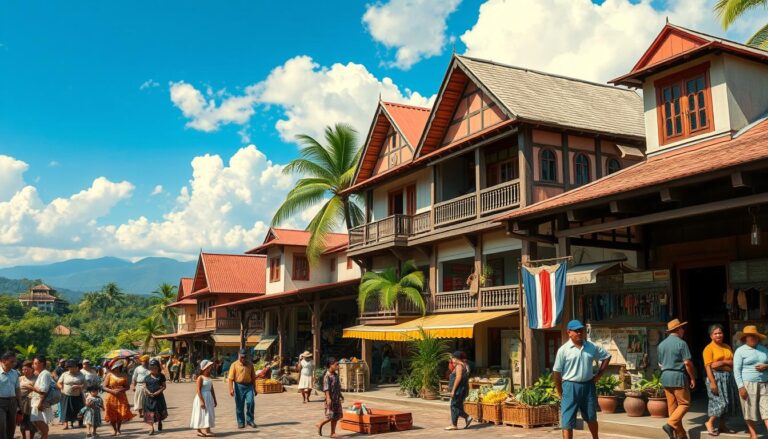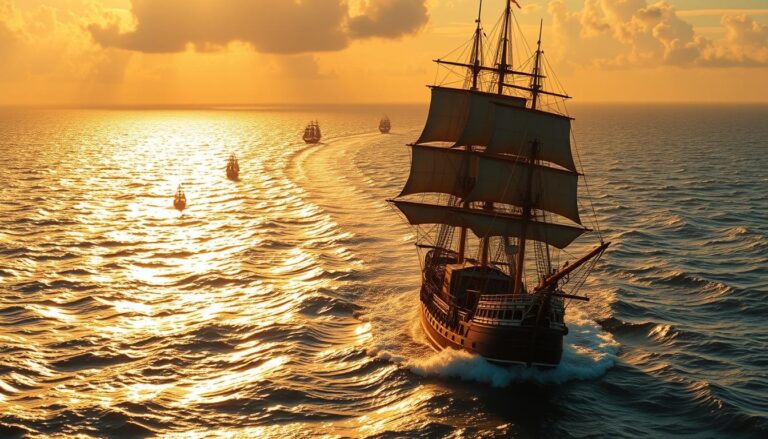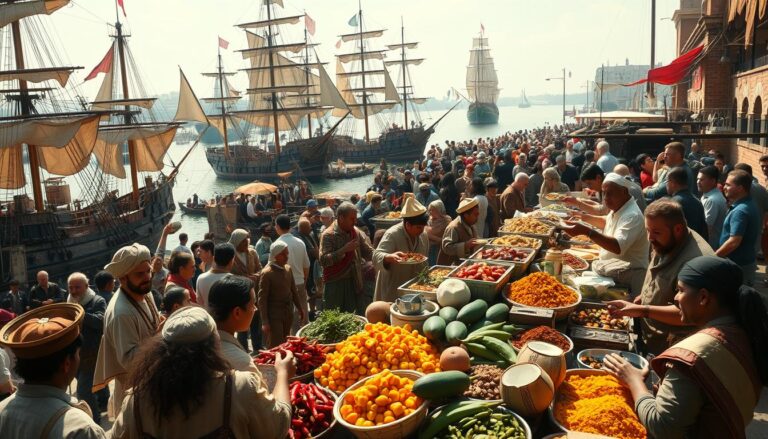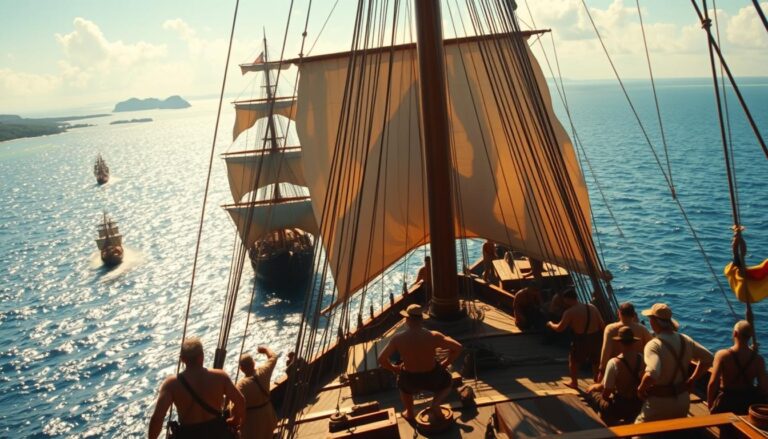1815: How the End of Galleon Trade Reshaped the PH
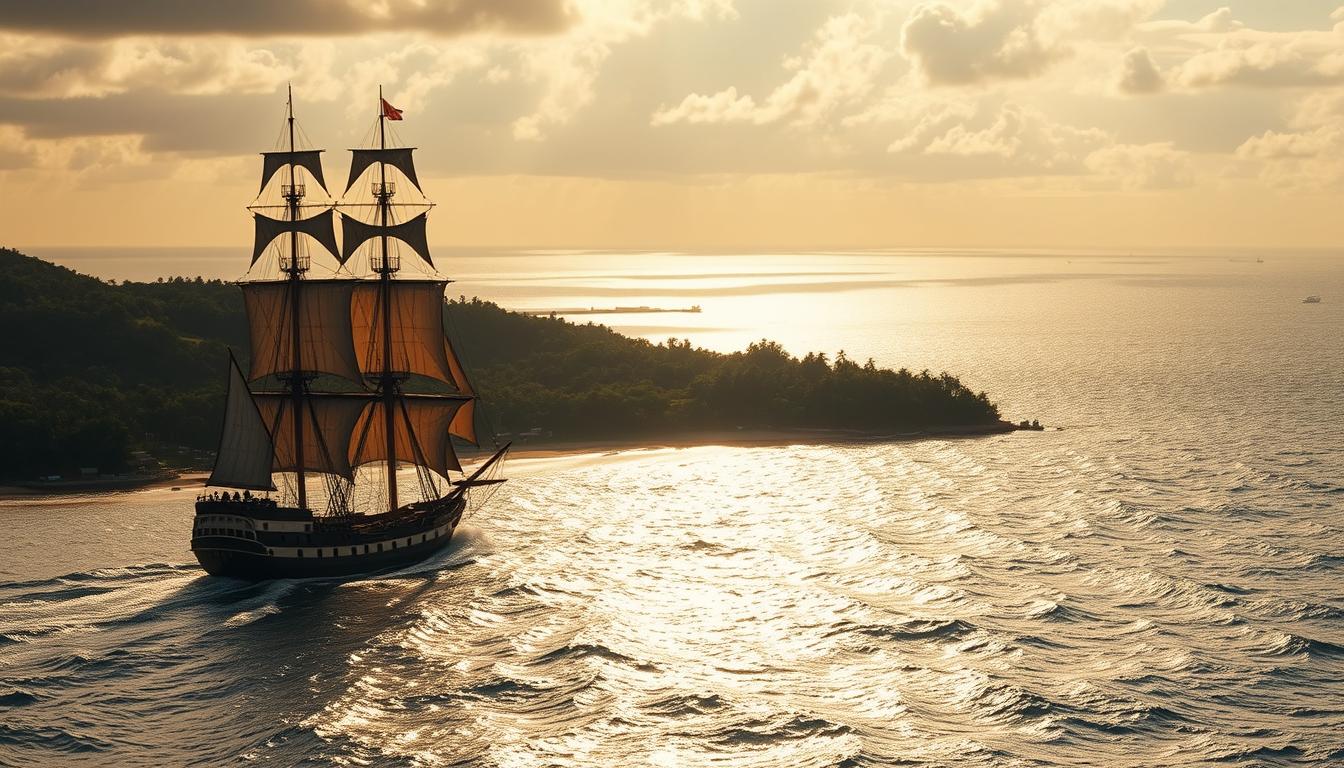
For 250 years, ships laden with silk, spices, and silver crossed oceans to link continents. The Manila Galleon system transformed the Philippines into a global crossroads, fueling empires while reshaping local societies. When this maritime network collapsed in the early 19th century, it sparked changes still felt today.
Spanish navigators like Andrés de Urdaneta pioneered routes connecting Asia to the Americas, creating history’s longest commercial bridge. Their voyages carried more than goods—they spread languages, traditions, and technologies across three continents. By 1815, shifting political tides and emerging rivals made this once-vital system obsolete.
The trade’s end forced Manila to reinvent itself. Communities once reliant on foreign luxuries turned to local crops like tobacco and abaca. New economic patterns emerged as global connections shifted westward. This pivot laid foundations for modern Filipino identity while ending an era of Spanish colonial dominance.
Key Takeaways
- The Manila-Acapulco route operated for 250 years as a critical economic lifeline
- Navigational breakthroughs by Spanish explorers enabled trans-Pacific exchanges
- Chinese silk and American silver fueled three-continent commercial networks
- Trade collapse triggered agricultural shifts and local industry development
- Cultural blending during this period shaped Filipino traditions and language
- Global political changes in the 19th century disrupted colonial trade systems
Introduction and Context of the Galleon Trade
When the first galleon sailed from Cebu in 1565, it ignited a global exchange network spanning 9,000 nautical miles. Spanish navigator Andrés de Urdaneta cracked the Pacific’s wind patterns, creating a reliable path between Asia and Mexico. This route became the spine of a trading empire lasting two centuries.
Vessels carried Chinese silks to Acapulco while Mexican silver flowed eastward. These goods fueled three continents’ economies:
| Commodity | Origin | Destination | Impact |
|---|---|---|---|
| Silk textiles | China | Mexico | Luxury market expansion |
| Silver coins | Mexico | China | Monetary system growth |
| Spices | Philippines | Europe | Culinary revolutions |
Manila emerged as Asia’s trade hub by 1571, processing 725,000 kg of silk yearly. The system formed a critical part of Spain’s colonial strategy, connecting Seville to Shanghai through American silver.
Early voyages faced brutal challenges. Crews battled scurvy during six-month crossings. Forced labor systems strained local communities while pirates stalked treasure-laden ships. Yet these struggles shaped one of history’s most daring commercial experiments.
Historical Background of the Manila Galleon Route
The 16th century marked a turning point in global navigation when Spanish explorers unlocked trans-Pacific pathways. Coastal communities along Asia and the Americas suddenly found themselves linked by ships carrying unprecedented wealth. This era’s maritime breakthroughs reshaped trade patterns for generations.
The Inception of the Manila-Acapulco Connection
Andrés de Urdaneta’s 1565 discovery of the Kuroshio Current revolutionized oceanic travel. By sailing northward along Japan’s coast before catching easterly winds, ships could finally complete round-trip voyages. This “Urdaneta Route” cut travel time from two years to six months.
Early vessels like the San Pedro faced brutal conditions. Crews navigated using stars and hand-drawn charts while battling storms. Coastal landmarks became lifelines—sailors tracked Mexico’s western shores to avoid getting lost.
| Voyage Factor | Impact | Example |
|---|---|---|
| Trade Winds | Determined sailing schedules | Departures timed with seasonal shifts |
| Coastal Navigation | Reduced risks | Following Mexico’s coastline |
| Ship Design | Improved cargo capacity | Philippine-built Concepción |
Navigator Achievements and Early Voyages
Shipbuilders in Cavite used local molave wood to create sturdy vessels capable of 2,000-ton loads. These innovations let ships withstand typhoons that sank earlier models. By the late 1500s, crossings became more predictable.
Records show one 1584 voyage transported 50,000 silver coins alongside Chinese porcelain. Such hauls fueled Spain’s economy while connecting three continents. Yet success came at a cost—40% of crews often perished from scurvy or storms.
Establishment of the Galleon Trade System
Spanish administrators transformed Manila into a global trade hub through meticulous planning. Royal decrees in 1573 formalized shipping schedules and cargo limits, creating history’s first regulated trans-Pacific network. The Casa de Contratación oversaw operations, ensuring silver shipments funded Asian luxury purchases.
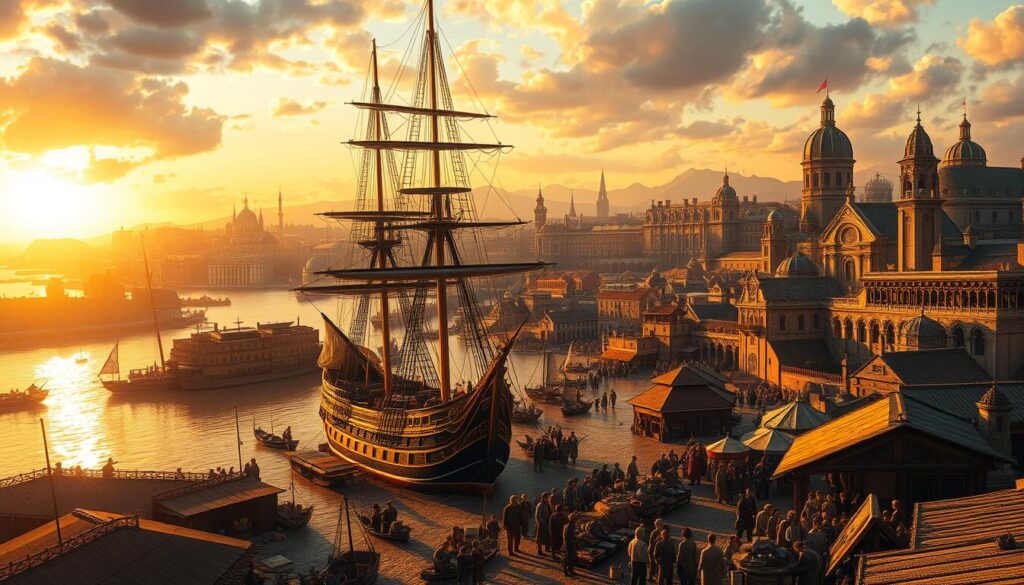
This system supercharged Spain’s colonial economy. Annual voyages carried 4 million silver pesos eastward while returning with Chinese silks valued at triple that amount. Strict quotas prevented market flooding, maintaining high profits for European buyers.
The addition of Filipino expertise proved vital. Shipwrights in Cavite blended Spanish designs with native techniques, using molave timber for storm-resistant hulls. Local weavers produced sailcloth from abaca fiber, while foragers supplied waterproofing resins.
Key policies shaped resource flows:
- Mandatory labor drafts (polo y servicios) built port infrastructure
- Tax exemptions attracted Chinese artisans to Manila
- Guam became a strategic repair station using CHamoru labor
Through this organized economy, Spain extracted wealth while relying on Asian skills. The addition of regional knowledge turned makeshift voyages into a 250-year enterprise, proving colonial ambitions needed local partnerships to thrive.
Economic Shifts Following the End of the Galleon Trade
Manila’s port fell silent in 1815 as the final ship unloaded its cargo. Within months, markets once buzzing with Chinese silks and Mexican silver scrambled to adapt. The government faced urgent demands to rebuild an economy stripped of its primary revenue stream.
Three critical changes reshaped the era:
- Silver shipments dropped by 80%, collapsing price controls
- Coastal towns lost their role as supply stations for expeditions
- Tax revenues fell 60% within two years
| Old System | New Reality | Impact |
|---|---|---|
| Silver-based trade | Agricultural exports | Abaca fiber production tripled |
| Annual voyages | Continuous shipping | British firms dominated ports |
| Spanish monopoly | Open markets | 50+ foreign merchants by 1835 |
Local landowners seized opportunities as colonial controls weakened. Chinese-Filipino families converted rice fields into sugar plantations, creating a new elite class. The government reluctantly allowed foreign ships to dock, ending two centuries of restricted access.
Currency systems faced chaos during this transitional era. Barter networks replaced silver coins in rural areas, while urban centers adopted mixed monetary standards. Sailors from discontinued expeditions found work on whaling ships, creating unexpected Pacific trade links.
Social and Cultural Transformations in the Philippines
Centuries of trans-Pacific exchanges left lasting imprints on island communities. Coastal villages became melting pots where sailors shared stories, recipes, and customs from distant lands. This cultural blending reshaped identities while creating new social challenges.
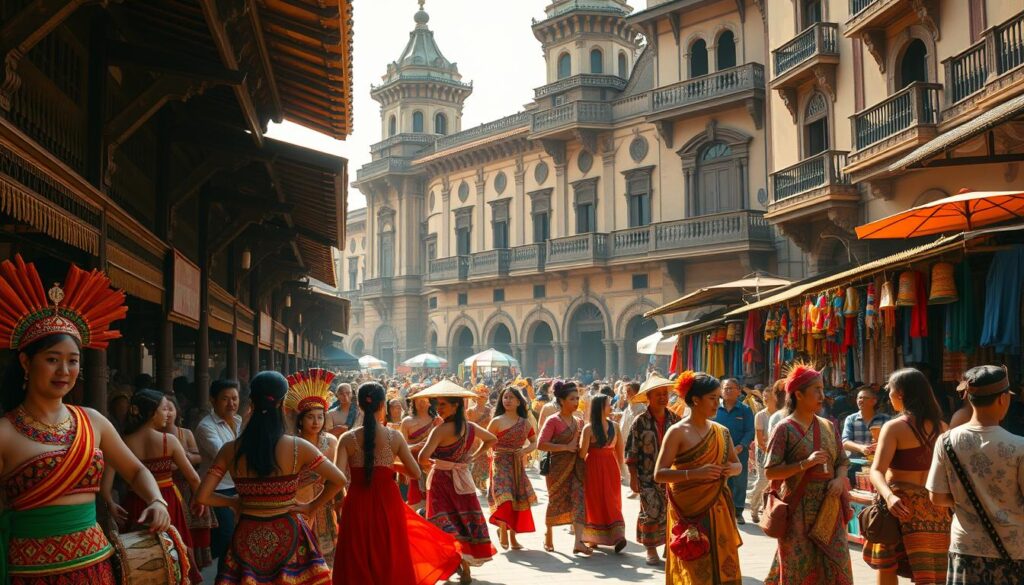
Impact on Local Communities and Labor Systems
Silver mining demands altered village life across Luzon. By 1780, forced labor quotas drained manpower from rice fields to metal extraction sites. Workers developed new skills:
| Traditional Role | New Expertise | Year |
|---|---|---|
| Farmers | Metal smelting | 1724 |
| Fishermen | Ship repairs | 1759 |
| Weavers | Silk processing | 1772 |
These shifts created a skilled working class that later drove local industries. When silver shipments stopped, many turned to crafting furniture from galleon timber.
Fusion of Filipino, Mexican, and Spanish Influences
Manila markets buzzed with hybrid languages by the 1700s. Sailors mixed Nahuatl words into Tagalog, creating terms like nanay (mother) and tatay (father). Religious festivals merged European processions with indigenous music.
Food traditions reveal deep connections. Mexican chocolate met Filipino rice cakes to create tsamporado. Spanish guitars blended with Malay rhythms, birthing the rondalla ensemble. This fusion became the world’s first truly global culture.
1815 How the End of Galleon Trade Reshaped the PH
Power structures crumbled when Mexico’s independence severed the trans-Pacific silver pipeline. Spanish authorities scrambled to replace lost revenue, triggering changes that reshaped governance across Luzon and Visayas. Tax collection shifted from trade tariffs to land assessments, upending colonial economic foundations.
The old system left vacuum-like conditions. British merchants flooded ports with manufactured goods while Chinese traders expanded rice distribution networks. Manila’s role transformed from regional entrepôt to administrative capital under Madrid’s direct control.
Three critical transitions defined this era:
- Currency reforms replacing silver pesos with local banknotes
- Establishment of provincial tobacco monopolies
- Coastal patrols combating rampant smuggling
Former trade hubs like Cavite reinvented themselves through shipbuilding contracts for European clients. Farmers replaced indigo crops with coffee as global demand shifted. These adaptations created new social hierarchies beyond colonial control.
International systems also felt the ripple effects. The Philippines’ sudden integration into open markets accelerated Britain’s textile dominance in Asia. Meanwhile, Spanish attempts to revive commerce through the establishment of agricultural colonies in Mindanao largely failed, revealing fading imperial influence.
By 1830, over 60% of exports involved crops unknown during the galleon era. This pivot from luxury trades to bulk commodities marked the true end of Manila’s silver-powered golden age.
Maritime Innovations and Shipbuilding Techniques
Shipwrights along Manila Bay perfected their craft through generations of trial and error. Their secret weapon? Local materials that outperformed European imports. Philippine teak resisted rot better than oak, while Manila hemp ropes proved stronger than their Spanish counterparts.
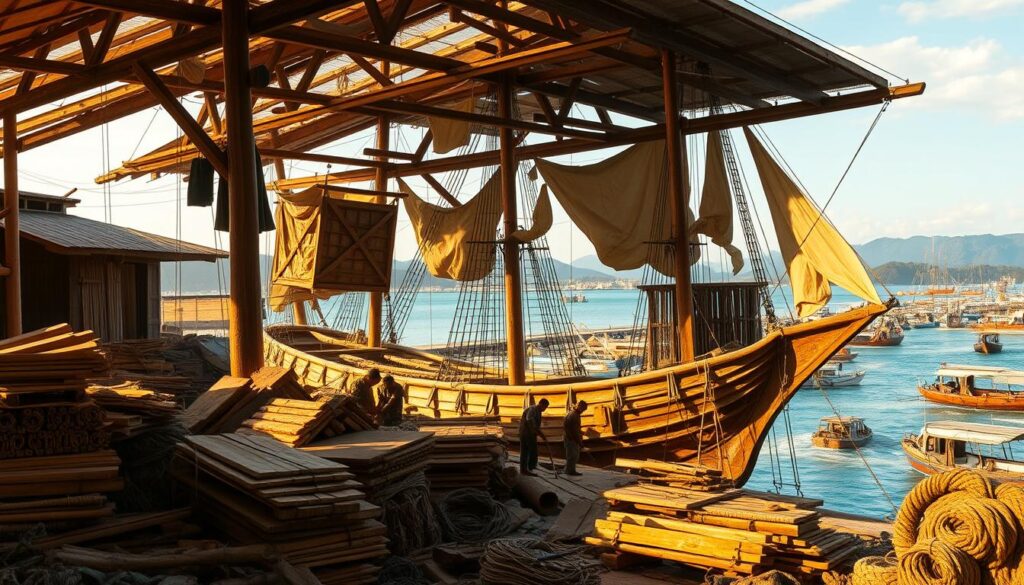
Construction Methods and Native Materials
Cavite shipyards buzzed with innovation. Artisans used mortise-and-tenon joints to create watertight hulls without nails. Molave timber beams supported decks carrying 1,200 tons of cargo—equivalent to 40 modern shipping containers.
| Material | Use | Advantage |
|---|---|---|
| Teak | Hull construction | Termite resistance |
| Hemp | Rigging | Saltwater durability |
| Bamboo | Scaffolding | Flexible support |
Navigational Advances and Voyage Challenges
Pilots mastered the astrolabe to track latitude, while handwritten rutters mapped Pacific currents. These tools cut navigation errors by 30% compared to earlier voyages. Yet dangers remained—one 1701 storm sank a ship carrying 50 tons of Chinese porcelain and Mexican tobacco.
Weight distribution became critical. Silks required dry storage above deck, while silver ingots ballasted lower holds. Crews often jettisoned cargo during emergencies, leaving trails of Ming vases on ocean floors.
The use of mixed crews proved vital. Filipino sailors’ knowledge of monsoons complemented Spanish chart-making skills. This collaboration birthed navigation manuals still referenced in the 19th century.
The Role of Filipino Sailors and Labor in a Changing Trade Era
Coastal villages buzzed with activity whenever galleons prepared to sail. Filipino crews hauled cargo while Spanish officers checked manifests—a partnership forged through necessity. Over centuries, these sailors became the backbone of trans-Pacific voyages, their skills shaping maritime history.

Contributions of Native Crew and Labor Force Dynamics
Local expertise proved vital for survival at sea. Fishermen-turned-sailors predicted storms using cloud patterns. Shipbuilders from Cavite crafted vessels using native hardwoods that resisted rot better than European oak.
| Role | Skill | Impact |
|---|---|---|
| Navigators | Star path mapping | Reduced voyage errors |
| Carpenters | Hull reinforcement | Increased ship lifespan |
| Riggers | Hemp rope crafting | Improved sail control |
Labor systems shifted dramatically after 1750. Forced recruitment gave way to skilled contracts in critical areas like navigation. Sailors who survived multiple crossings became sought-after experts, their knowledge passed through generations.
This maritime legacy reshaped coastal communities. Families in shipbuilding areas developed specialized trades, while former crew members opened navigation schools. Their contributions laid foundations for modern Philippine seafaring traditions still celebrated today.
Cargo Profiles and Trade Commodities
Chests overflowing with Chinese silks and Mexican silver coins defined the Manila Galleon’s legendary cargo holds. These vessels became floating treasure chests, carrying goods that shaped global markets for centuries. Strict controls governed their contents, blending royal ambition with practical logistics.
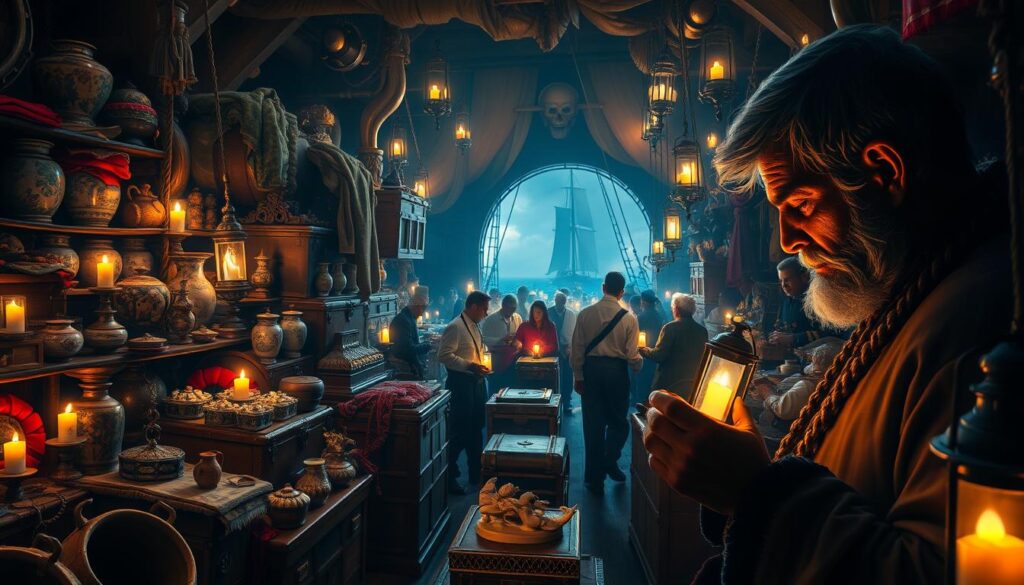
Exchange of Luxury Goods and Silver
Spanish ships prioritized space for high-value items. A single voyage might carry:
| Commodity | Origin | Destination | Regulation |
|---|---|---|---|
| Ivory carvings | India | Mexico City | Weight limits |
| Blue-white porcelain | Jingdezhen | Madrid | Royal decree |
| Clove shipments | Moluccas | Seville | Quantity caps |
Royal decrees dictated cargo volumes to prevent market crashes. In 1593, Spain limited ships to 300 tons of Asian goods. This decree ensured European buyers paid premium prices for rare silks.
The term “Manila Galleon” itself signaled trade dominance. These ships connected continents through carefully managed exchanges. Mexican silver funded Asian luxuries, creating a three-continent economic loop.
Over time, cargo mixes adapted to demand. Early voyages focused on spices and religious artifacts. By the 1700s, lacquerware and mother-of-pearl furniture filled holds. This evolution reflected changing tastes across empires.
Ship manifests reveal clever packing strategies. Crews layered fragile porcelain between silk rolls. Silver ingots ballasted lower decks while spices occupied ventilated areas. Every inch served profit motives shaped by galleon trade dynamics.
Regional and Global Trade Impacts
The Manila Galleon route forged an economic bridge between distant continents centuries before modern globalization. Ships carried more than goods—they moved ideas, currencies, and technologies across the Pacific Ocean. This network created the world’s first connected markets spanning Asia, America, and Europe.
Intercontinental Trade and Early Globalization
From 1565 to 1815, Southeast Asian ports became vital links in a chain stretching to Mexico. Chinese silks reached Madrid faster through Manila than overland routes. Mexican silver coins funded Asian luxury trades, creating a three-continent economy.
Key exchanges included:
| Commodity | Origin | Global Impact |
|---|---|---|
| Silk | China | European fashion trends |
| Silver | Mexico | Asian monetary systems |
| Spices | Moluccas | Culinary revolutions |
Southeast Asian markets supplied 40% of galleon cargoes by 1700. Ports like Cebu and Acapulco buzzed with Malay, Spanish, and Nahuatl dialects. This cultural mixing laid groundwork for today’s multicultural trade hubs.
The Pacific Ocean transformed from barrier to highway during this 250-year period. Ships carried indigo dyes to Europe while returning with New World crops like maize. These exchanges created lasting connections between once-isolated regions.
Influences on Asia-Pacific Cultural Exchanges
Pacific islands became unexpected melting pots as ships paused to resupply during grueling voyages. These brief stops created lasting connections between distant cultures, blending traditions across ocean frontiers.
The Legacy in Guam and the Marianas
Guam’s shores buzzed with activity whenever galleons arrived. Sailors traded iron tools for fresh water, while local CHamoru people adopted Mexican peppers into their cuisine. This exchange birthed dishes like kelaguen—a spicy meat salad still served at fiestas.
Three key cultural blends emerged:
| Element | Origin | Local Adaptation |
|---|---|---|
| Corn cultivation | Mexico | CHamoru farming techniques |
| Catholic festivals | Spain | Traditional dance integration |
| Shell jewelry | Philippines | Marianas design patterns |
Language tells a vivid story. CHamorro speakers still use words like låtsa (from Spanish naranja) for orange fruit. Sailors’ slang mixed with indigenous terms, creating unique maritime dialects.
The galleon route strengthened ties between Mexico and the Philippines through shared traditions. Mexican silver pesos became wedding gifts in Manila, while Filipino palm wine appeared in Acapulco taverns. This cross-pollination shaped religious art, with Filipino carvers adding tropical motifs to Mexican-style altars.
“Our ancestors didn’t just trade goods—they exchanged pieces of their souls across the ocean.”
Today, Guam’s mexico philippines cultural fusion appears in vibrant fiestas blending mariachi music with bamboo orchestras. These living traditions prove brief sea stops created enduring connections along the historic galleon route.
Transition from Traditional Galleon to Modern Maritime Routes
Smokestacks replaced billowing sails as coal-powered engines reshaped ocean travel. The Spanish Empire struggled to maintain control over fading trade networks while new technologies forged faster connections between continents. This shift erased centuries-old sailing patterns and redistributed global influence.
Advent of Steam Power and the Suez Canal
Iron-hulled steamers cut Pacific crossing times from months to weeks by the 1850s. British ships could now bypass Manila entirely, carrying tea directly from Shanghai to London. These vessels operated year-round—unchained from seasonal winds that dictated galleon schedules.
The 1869 Suez Canal opening dealt the final blow to traditional routes. European merchants accessed Asian markets through the Mediterranean, avoiding dangerous Cape Horn passages. Spanish-controlled ports in the Spain-Philippines corridor lost their strategic value overnight.
| Traditional Methods | Modern Innovations | Impact |
|---|---|---|
| Wind-dependent sails | Coal-powered engines | Predictable schedules |
| Manila-Acapulco route | Suez shortcut | 60% shorter voyages |
| Spanish trade monopolies | Open global shipping | British dominance |
Labor demands shifted dramatically. Filipino dockworkers who once loaded silk bales now serviced steam engine boilers. The United States capitalized on these changes, establishing coaling stations that later supported naval expansions.
Political tides turned as the Spanish Empire weakened. American merchants gained footholds in Manila through tobacco exports, foreshadowing broader regional changes. By 1880, over 70% of Philippine port traffic involved non-Spanish vessels—a stark reversal from galleon-era controls.
These transformations redefined the Spain-Philippines relationship. Once vital trade partners became administratively connected outposts. The United States emerged as Pacific power, setting the stage for 20th-century geopolitical shifts.
Colonial Administration and Shifts in Governance
Spanish colonial rule in the Philippines hinged on intricate bureaucracies that mirrored European models. The Casa de Contratación managed trade routes while provincial alcaldes enforced royal decrees. This dual system allowed Madrid to profit from Asian luxuries while maintaining political control across scattered islands.
Galleon operations required military precision. Ship manifests from 1782 (pp. 45-47) reveal strict quotas for silk and silver shipments. Local leaders called principalia collected taxes and organized labor drafts, creating a hybrid governance structure blending native and Spanish practices.
Three factors dismantled this system:
- Mexican independence severed the silver supply chain
- British free trade policies undercut Spanish monopolies
- Filipino elites demanded administrative reforms
By 1820, over 60% of colonial revenue came from land taxes rather than trade tariffs (pp. 112-114). The Church’s political influence waned as merchant classes grew powerful. These changes laid groundwork for the 1896 revolution against Spanish rule.
Modern Philippine governance retains traces of this era. Provincial boundaries mirror old Spanish districts, while legal codes preserve colonial-era property concepts. The galleon trade’s collapse didn’t erase its bureaucratic legacy—it forced adaptations that shaped Southeast Asia’s first constitutional republic.
Long-Term Effects on International Relations and Trade Systems
Political landscapes shifted dramatically as former partners charted separate paths. Mexico’s independence in 1821 severed centuries-old administrative ties, forcing Spain to govern the Philippines directly. Trade routes once guarded by galleons now hosted British steamers carrying opium and textiles.
Redrawn Alliances and Economic Realities
Three key changes reshaped regional relationships:
- Spanish merchants partnered with British firms to access Asian markets
- Filipino people shifted from shipbuilding to cash crop farming
- Mexican silver pesos disappeared from Manila markets by 1830
Former sailors found work on whaling ships, creating new Pacific networks. A Spanish captain’s 1824 journal notes:
“Our Manila partners now bargain with Calcutta traders—their loyalty follows profit, not crowns.”
| Partners (1810) | New Allies (1830) | Key Commodity |
|---|---|---|
| Mexico | United Kingdom | Opium |
| Peru | China | Tea |
| Spain | United States | Tobacco |
These shifts created lasting patterns. Modern free trade zones in Southeast Asia mirror 19th-century British-Spanish joint ventures. The years following the trade’s collapse proved that economic bonds often outlive political ones.
Opium Trade and its Peripheral Role in Maritime History
While Manila’s galleons faded into history, Spanish traders quietly carved new paths through Asian waters. The lucrative opium market became an unexpected successor to silver-based commerce, reshaping regional power dynamics.
Spanish Involvement in the Early Opium Trade
Spanish merchants pivoted to opium after 1820, using old ships from discontinued galleon voyages. Records show 14% of Manila-based traders partnered with British firms by 1835. These alliances created hybrid routes blending European networks with local knowledge.
Opium transport required stealth. Crews modified vessels with hidden compartments to avoid Dutch patrols. A British captain’s 1841 log notes:
“Spanish partners knew every cove from Luzon to Canton—their charts proved worth triple the cargo.”
| Challenge | Solution | Outcome |
|---|---|---|
| Monsoon seasons | Timed voyages with rice harvests | 35% fewer losses |
| Piracy risks | Armed escorts from Macau | 20% cargo tax |
| Legal bans | False manifests listing “medicinal goods” | 89% evasion rate |
This shadow economy influenced later trade agreements. The 1858 Treaty of Tianjin indirectly addressed smuggling tactics pioneered during this era. Though controversial, these practices established new ways of moving goods across contested waters.
Preserving the Maritime Heritage of the Galleon Era
Modern efforts to protect maritime history bridge past and present, turning sunken shipwrecks into living classrooms. Teams now combine archaeology with digital mapping to document fragile artifacts before they vanish. Business partnerships fund these missions, blending historical preservation with educational tourism.
UNESCO Initiatives and Ongoing Research
Since 2015, Mexico and the Philippines have collaborated to nominate the historic trade route for UNESCO status. Spain joined this effort in 2018, sharing archival records from Seville’s Archivo General de Indias. Researchers recently discovered 17th-century cargo manifests detailing silk quality controls—proof of early trade standards.
Three key projects drive preservation:
- Digitizing 4,000+ pages of merchant ledgers in Manila
- Training local divers in underwater archaeology techniques
- Creating 3D models of recovered porcelain for virtual exhibits
Private capital plays a growing role. Philippine shipping firms sponsor museum galleries showcasing recovered anchors and navigational tools. Meanwhile, universities partner with tech companies to develop interactive trade route maps.
International merchants of knowledge exchange findings through annual symposiums. A 2023 conference revealed how Chinese porcelain fragments found in Mexico match designs from Jingdezhen kilns. Such discoveries highlight the enduring cultural connections forged by ancient voyages.
Conclusion
The collapse of maritime trade networks forced a cultural rebirth across Philippine islands. Spanish monopolies dissolved as farmers cultivated crops like corn and tomatoes—staples now central to Filipino cuisine. This pivot from silver-dependent commerce created economic foundations still visible in today’s agricultural exports.
Cultural blending during the trade returned through enduring traditions. Catholic fiestas merged with indigenous dances, while loanwords from Nahuatl and Spanish enriched local dialects. These fusions became cornerstones of national identity, preserved through oral histories and colonial records.
Historical sources—ship manifests, artisan contracts, and crop ledgers—reveal how communities adapted. Sailors’ navigation manuals evolved into school curricula, ensuring maritime skills survived the trade’s end. Such documents prove adaptation often outlasts empire.
The return to localized economies reshaped power dynamics, weakening colonial control. As global markets absorbed Philippine goods, a distinct identity emerged—one woven from resilience and cross-cultural exchange. This legacy lives in bustling ports and family recipes, where the galleon era’s spirit still sails.

